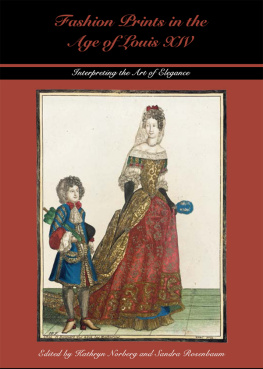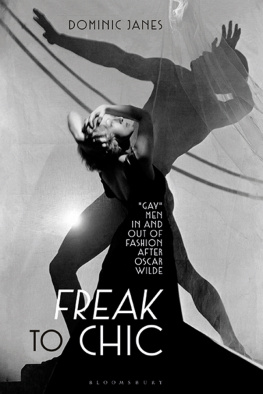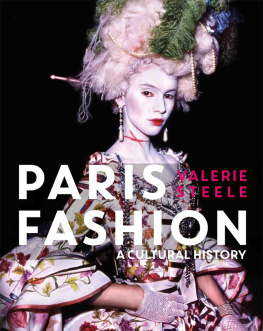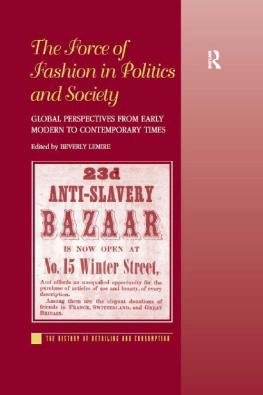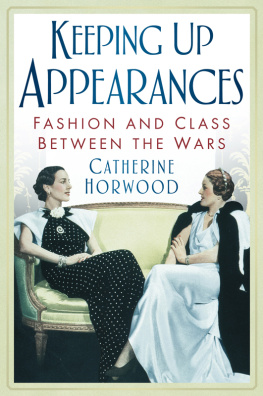Dandies
Dandies
Fashion and Finesse in Art and Culture
EDITED AND WITH AN INTRODUCTION BY
Susan Fillin-Yeh

NEW YORK UNIVERSITY PRESS
New York and London
2001 by Susan Fillin-Yeh
All rights reserved
Library of Congress Cataloging-in-Publication Data
Dandies : fashion and finesse in art and culture /
edited by Susan Fillin-Yeh.
p. cm.
Includes bibliographical references and index.
ISBN 0-8147-2695-X (cloth : alk. paper)
ISBN 0-8147-2696-8 (pbk. : alk. paper)
1. DandiesHistory. 2. Mens clothingHistory.
3. FashionHistory.
GT6720 .D35 2000
305.31dc21 00-012369
New York University Press books are printed on acid-free paper,
and their binding materials are chosen for strength and durability.
Manufactured in the United States of America
10 9 8 7 6 5 4 3 2 1
For J. and K.
Contents
Susan Fillin-Yeh
Rhonda K. Garelick
Robert E. Moore
Carter Ratcliff
Susan Fillin-Yeh
Joe Lucchesi
Jennifer Blessing
Kimberly Miller
Richard J. Powell
Mark Allen Svede
Rhonda K. Garelick
Illustrations
Preface
An image wisp from memory has persisted as this book took shape: a woman who steps briskly out of her door very early in the morning. She is wonderfully turned outhat, gloves, burnished shoe leather. The time is the 1930s or 1940s (my mothers history enters in here). Her stocking seams are perfectly straight. She passes by weedy, brick- and trash-strewn vacant lots and the streets on which she walks are dingy and unprepossessing, for few people enliven them and the stores are not yet open. She is resplendent.
But is she a dandy? In conventional thinking, no. She almost certainly has never experienced the leisure time supported by money historically implicated in dandyism. (If you want to be a dandy, make sure that you are rich, Charles Baudelaire advised.) And she doesnt trace a lineage back to the fantastically dressed eighteenth-century English Macaronis, or to George Bryan Beau Brummell, whose austere elegance of costume and demeanor positioned him as the cynosure of royalty. But, as with Brummell, her clothing is her armor, and her presence and presentation are gifts to those who look at her. Her apparition invokes one task of Dandies: Fashion and Finesse in Art and Culture: to suggest a new paradigm for dandies, a robust and diverse outsider paradigm of sartorial finesse detached from Western European upper-class dandyismtraditional, mainstream, and gendered as male (see Introduction: New Strategies for a Theory of Dandies). This paradigm is imbued with realizations gleaned from a generations measure of feminist scholarship, though its shortcomings are my own. Such a paradigm can render my memory womans unrecognized dandyism visible. And other dandyisms as well.
This book has come into being thanks to its contributors, Jennifer Blessing, Rhonda K. Garelick, Joe Lucchesi, Kimberly Miller, Robert E. Moore, Richard J. Powell, Carter Ratcliff, and Mark Allen Svede. Their enthusiastic participation and thoughtful scholarship have produced essays on late-nineteenth- and twentieth-century artist dandies; dandy fashion stars, African dandies, Native American trader-tribe dandies, African American dandies, and Latvian dandies. Their work has affirmed my conviction that a project of this scope, with roots in art history, cultural history, literary scholarship, material culture, and anthropology, and a theoretical lineage in postmodernist, postcolonialist, and feminist theory, queer theory, and fashion history, finds its most evolved expression and far-reaching impact as a joint effort. As does clothing itself. A text, as Roland Barthes pointed out, is a tissue. The essays in this volume remind us that garmentsin actuality and metaphoricallyare constructs, and that in studying them, one carries out deconstructive tasks.
The idea for the project originated in a conversation with Whitney Chadwick, whose broad vision of scholarship is inspiring. Robert Farris Thompson was encouraging at a very early stage, as was my editor at New York University Press, Eric Zinner, whose belief in this project has been essential in its evolution. I thank Harriet Watson for her support and help in engineering leave time to work on this book, and Silas B. Cook for serving as acting director of the Douglas F. Cooley Memorial Art Gallery, Reed College, in my absence. Joan and John Shipley lent their beach house. I was inspired by lively exchanges with friends and colleagues Robert Moore and Mark Svede and thank Julia Ballerini, Kate Mai-lan Fillin-Yeh, and Lena Lencek, who generously read the manuscript and offered a great many valuable suggestions. I thank Kate Fillin-Yeh for the deconstruction discussion, and Jennifer Robertson for the photograph of Anna Jun. Naomi Sawelson-Gorse was instrumental in organizing preliminary editorial tasks of the book, and Christina Houstian has been a meticulous and cheerful editorial force, as was Nadine Fiedler. Despina Papazoglou Gimbel, managing editor at New York University Press, was gracious and thorough, as was indexer Julie Kawabata. I thank Professor Kathrine French for generously helping me edit a chapter. Aaron Jones and Sarah Hamill fed lists of books to the Reed College Interlibrary Loan Office, whose staff was unfailingly helpful. Marv Dunn untangled computer languages. The College Art Association offered me the opportunity in 1997 to organize a session on dandies that introduced me to new contributors. Amy Jo Fillin supplied me with New York Times clippings. I thank Jen Yeh for finding me books, and for his love and constant support; this project could not have come to fruition without him.
Introduction
New Strategies for a Theory of Dandies
Susan Fillin-Yeh
Dandyism is a mysterious institution.
Charles Baudelaire, 1863
For a while when he was in his twenties, Charles Baudelaire impressed Bohemian friends with his dandyism. Dressed completely and startlingly in black (the necessary garb, he wrote, of our suffering age), in elegant clothing tailored to his own instructions, Baudelaire set out to address dandyism in his writing.
Baudelaire offers us jumping-off points for a discussion of dandies: cosmopolitanism, presentation, spectacle, moral mechanism[s]. His dandyism conjoins clothingpersonally intimate and literally materialand
Might Baudelaire have recognized Coco Chanel as a kindred spirit? Perhaps not, although he came close to suggesting that dandies and women were alike in their cultivation of artifice.
Why study dandies? Certainly because new ones continue to flourish. Dandies resistance to norms has found many outlets in the twentieth century; contemporary life and events have invoked (and provoked) dandyism. (Andy Warhols downtown style that blended punk, camp parody, and glamour identifies him as a dandy; Madonnas seemingly endless parade of invented selves is dandyesque.) In directing attention to overlooked dandies at particular times and specific places who have devised sartorial strategies that forge new identities and selves, Dandies: Fashion and Finesse in Art and Culture juxtaposes theoretical models, evocative images, and actual clothing. Style is a mode of confrontation. Multivalenced perspectives in diverse approaches and subject matter offer new insights into the obstreperous phenomenon of dandies, for one thing, noting their courage.
It has taken the vast changes in thinking about identity offered by feminist theory, queer theory, and other studies of women subsumed under the rubrics of deconstruction and postmodernist discourse to
Next page

